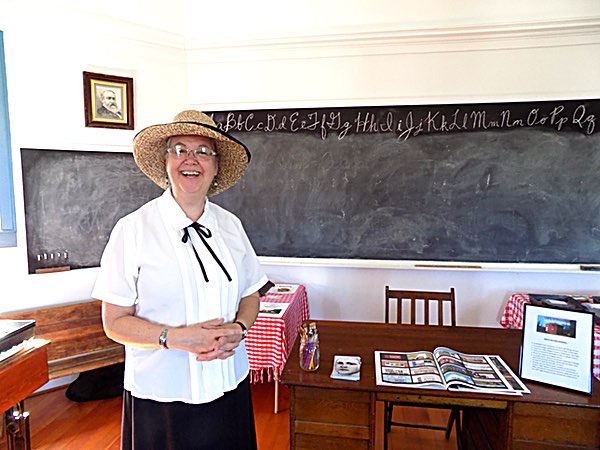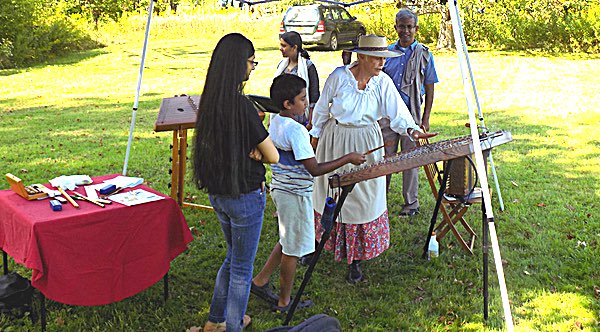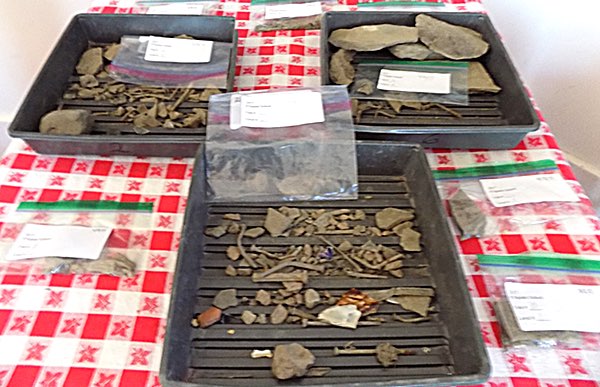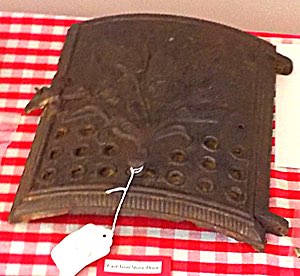- By Dan Veaner
- Around Town
 Print
Print 
Dryden's Eight Square Schoolhouse celebrated its 190th birthday Saturday with ice cream, cake and live 19th century music. A steady stream of people toured the building and grounds to get a taste of what going to school in the late 1800s was like. Schoolmarm Wendy Bacon was at the front door, school bell in hand, to welcome visitors on this special weekend school day.
"Here in the school house it's 1892," explains Bacon. "The 4th graders come here on a field trip. The bus pulls up I am standing on the steps ringing the dickens out of my school bell. I'm usually wearing leather boots with a full length black skirt, white blouse with a high neck and long sleeves, and, of course, a little gray bun."
"We reenact a day in 1892 for the kids," says Living History Program Director Carole West. "It was the 400th anniversary of Columbus coming to America and there was a huge patriotism boom in the country. It was the first year that kids said the Pledge of Allegiance. It was the first year that all the schools had to have a flag, and the kids had to buy the flag. It cost $25, and the kids were asked to save their pennies to buy it for the school. The patriotism movement was to unify the curriculum, but also to get the kids interested in their country, in being patriotic, in being loyal... it was an interesting time."
While history and archaeological programs are offered, the mainstay of the Living History program is a trip back in time for fourth graders. Fourth graders from Lansing, Trumansburg, Ithaca, Newfield, Montessori schools, private and home-schooled students get to spend a day learning lessons from a primer of the period, blackboard lessons on cursive writing, slates used in math lessons, and pen and ink. West says she hopes to add the remaining school districts so all Tompkins County fourth graders can live the experience.
Students are immersed in the historical day from the moment they step off the bus. While some things never change, going to school in the late 19th century was also quite different. The curriculum included cursive writing, and there were no computers or electronic anything. In fact, there was no electricity. The school room was heated by a stove in the center of the room, with boys on one side and girls on the other. Discipline was strict, and plumbing was nonexistent except for a pump outside the schoolhouse.
 1892 schoolmarm Wendy Bacon
1892 schoolmarm Wendy Bacon"I tell them to line up," Bacon says. "We circle the flag pole, and we raise the flag with 44 stars and talk about why there are 44 stars on our flag. Then they come inside, and the boys sit on one side and the girls sit on the other. We spend the whole day in 1892.We do math and reading and grammar. We do geography with these two maps that are actually from the period. Some kids don't like the pen and ink, and they don't like it when they get it on their clothes. Some kids don't like the privies either!"
At the end of the day, the kids spend a few minutes in their own time, comparing their usual classroom experiences with those of the day before getting back on the bus to go home.
"It is fun," Bacon says. "It's a long day, but it is enjoyable. Every once in a while there is a kid who discovers that they have an absolute gift for pen and ink, and they love it. That's really exciting."
The last student who attended the school as part of the final class of 1941 died three or four years ago. The History Center purchased the building for $10 in 1955. It was used for storage until the Cayuga Nature Center held classes there in the 1980s, and the current Living History program was begun in 1992.
"Eight sided buildings were initiated by the Quakers," West says. "We think that's where this design came from. The founding fathers of the school were wealth men in Dryden who did a lot of research before this was built. They wanted something that would last, which is why they built it in brick. They also wanted something that would be optimal in terns of space. So I think the eight sided building made sense to them."
 Gail Cashen (wearing a hat) demonstrates period instruments and allows visitors to try them out.
Gail Cashen (wearing a hat) demonstrates period instruments and allows visitors to try them out.Gail Cashen brought musical instruments of the period to the open house. She encouraged visitors to play them, and she played period melodies as well. One of the programs to offered for 8 to 13 year-olds is based on the diary of Carrie Manning, a local girl who was 13 when she wrote the diary.
"These are the instruments she mentioned in her diary: hammered dulcimer; a melodian, which is a kind of button accordion; a jaw harp, also called a Jew's harp; recorders, a fife, penny whistles," Cashen said. "Many of these instruments are still used."
 Artifacts found around the school in an ongoing archaeological program
Artifacts found around the school in an ongoing archaeological program Stove door found on the grounds of the Eight Square SchoolhouseThe octagonal brick building replaced an 1814 four-sided schoolhouse at a cost of $550.88 in 1927. West says she knows of a stone eight-sided schoolhouse in Essex County, but the brick Dryden school is fairly unique. Among the artifacts discovered by archaeologists is a beautiful cast iron stove door, which bacon says speaks to the care and quality Dryden parents lavished on their kids' education.
Stove door found on the grounds of the Eight Square SchoolhouseThe octagonal brick building replaced an 1814 four-sided schoolhouse at a cost of $550.88 in 1927. West says she knows of a stone eight-sided schoolhouse in Essex County, but the brick Dryden school is fairly unique. Among the artifacts discovered by archaeologists is a beautiful cast iron stove door, which bacon says speaks to the care and quality Dryden parents lavished on their kids' education."This building was very high end for it's time," Bacon says. "This was cutting edge architecture, state of the art in education when it was built. This was as good as it gets for education of that period, and it's still a great space to teach in. The people of this community were pouring money into their kids' education. These people were buying the best for their kids."
The History Center began holding annual open houses 15 years ago. This year's event featured Cornell Senior Lecturer Rhonda Gilmore, an expert in octagonal architecture. Later in the afternoon a Cornell professor demonstrated flint knapping, the shaping of flint tools. Two archaeologists showed an active dig site, and many artifacts were on display inside the schoolhouse. In the schoolyard kids played games of the period. And, this being an impressive 190th birthday celebration, there was ice cream and cake.
"It's been fun, and we had a beautiful day," Cashen said. "Ice cream and cake, and what more could you want?"
v13i38



